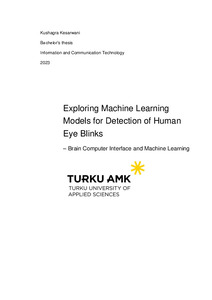Exploring Machine Learning Models for Detection of Human Eye Blink : brain-computer-interface and machine learning
Kesarwani, Kushagra (2023)
Kesarwani, Kushagra
2023
Julkaisun pysyvä osoite on
https://urn.fi/URN:NBN:fi:amk-2023110128293
https://urn.fi/URN:NBN:fi:amk-2023110128293
Tiivistelmä
Brain-computer interface (BCI) technology offers promise for enriching human-computer interactions across diverse domains. This thesis focuses on blink detection within BCI systems and their potential applications. The methodology encompasses data collection, EEG pre-processing, and model training. EEG data collected using the Ultracortex Mark IV headset was labeled for four categories. Various machine learning models were trained and evaluated, with the multi-layer CNN achieving a top performance of 74.70%. The results provide a foundation for advanced BCI projects, including assistive technology and hands-free systems, and suggest the need for hardware upgrades to expedite training. Future work entails data collection from multiple individuals, exploring real-world data collection settings, additional EEG nodes, and real-time applications.
In summary, this research advances BCI by addressing blink detection, enhancing human-computer interactions in healthcare, gaming, communication, and assistive technology.
In summary, this research advances BCI by addressing blink detection, enhancing human-computer interactions in healthcare, gaming, communication, and assistive technology.
